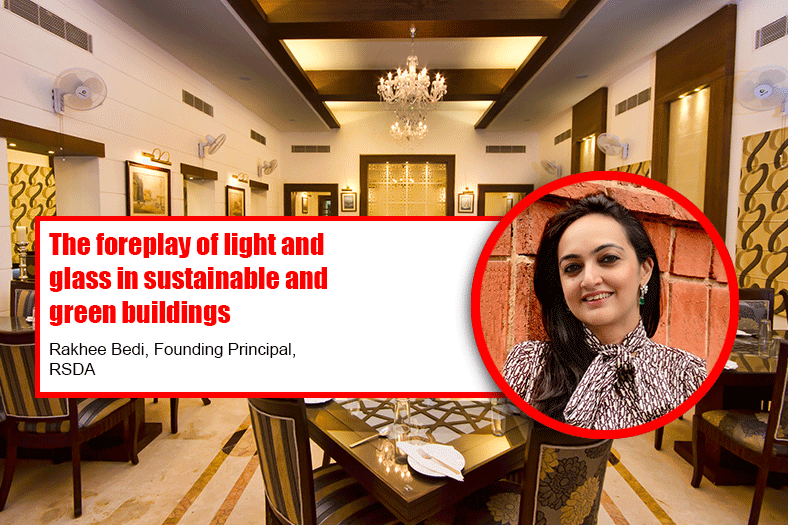The foreplay of light and glass in sustainable and green buildings

From energy efficient facades to circadian lighting systems, the importance of light and glass is paramount in buildings advocating sustainability points out Rakhee Bedi, Founding Principal, RSDA, a multi-disciplinary design firm.
Glass and beautiful interiors
Glass partitions are mostly used as decorative elements as they do not create strong visual barriers, nor are they very good sound insulators. However, they add a lot of character, colour and texture in the space. Glass partitions are typically used to bring in more natural light, which makes the space look less crowded. Besides, glass is a very versatile material which makes way for creative as also user end customisation.
When light scatters through a translucent glass facade, the space looks much brighter. Glass increases the aesthetic appeal of even small spaces. Glass doors and partitions can be easily installed. An in case of privacy concerns, glazed doors and partitions are also an option.
An important component of green buildings
In a country like India, where most parts in India have a tropical climate, glass in green buildings needs to be carefully mapped and implemented. The focus of green buildings is on energy-efficient facades; together with technological advancements, “intelligent” glass facades have been developed, which adapt to the external and internal climatic conditions.
Recyclability of glass and sustainability
The fact that glass is a recyclable material makes it an important component in green buildings. When used carefully, glass can improve that the energy efficiency of the building. Along with tangible benefits, glass helps in enhancing the indoor air quality. Glass facades allow adequate natural light to enter the house benefitting the general health and well-being of the occupants.
Use of light in interior design
We don’t realise it, but light is perhaps one of the most important element in interior design. Lighting plays with our perceptions, while creating unique sensations and experiences, thereby transforming design. It has the ability to change the mood of a room and even the perceived size of the room.
Creating different moods
When designing a space, it is essential to define the experience that we want to create. Dim and indirect lighting tends to create a more intimate space that encourages relaxation, while white and direct lighting activates our brains and allows us to see smaller details. We choose the type of light depending on the design concept that we have in mind and the room it will be utilised in. Lighting is an element which we incorporate in response to the need and essence of the project itself.
In formal areas, a sculptural element like a pendant glass chandelier might not always be a good idea as it impacts the interior design and becomes a focal point of the space. However, decorative lights can add colour and texture or a visual impact and to the furniture and walls to get the desired result.
A tall table lamp in clear or tinted glass not only helps in enhancing the luxury quotient of the space but also declutters the space. In contrast, the large fabric lamp shades help in brightening up commercial spaces in a subtle manner, for informal spaces such as balconies, pendant lights that add an aesthetic value suits the best. Wellness projects such as salons and spas demand a well-strategized lighting design, not only to create a rejuvenating experience, but to attain a signature décor language. Organic and parametric designs are now defining the design vocabulary of such spaces.
Green lighting
Green lighting design matches the amount and quality of light to the function of a space. Sections of lighting for different areas or different functions should be on separate controls, to allow users of a space to decide how much light is needed. Task lights should be installed wherever needed and ambient light reduced elsewhere. Occupancy sensors that automatically turn lights on and off as needed can reduce energy use while having a minimal impact on building occupants. Opportunities for daylighting should be maximized, while controlling glare and unwanted heat gain.
Spatial lighting systems are both a heavy consumer of energy and a significant source of internal heat. However, efficient green buildings are incorporating automated and circadian lighting systems which are useful for cutting operational lighting costs significantly while enhancing lighting quality, reducing environmental impacts, and promoting health and work productivity.
16
Cookie Consent
We use cookies to personalize your experience. By continuing to visit this website you agree to our Terms & Conditions, Privacy Policy and Cookie Policy.









